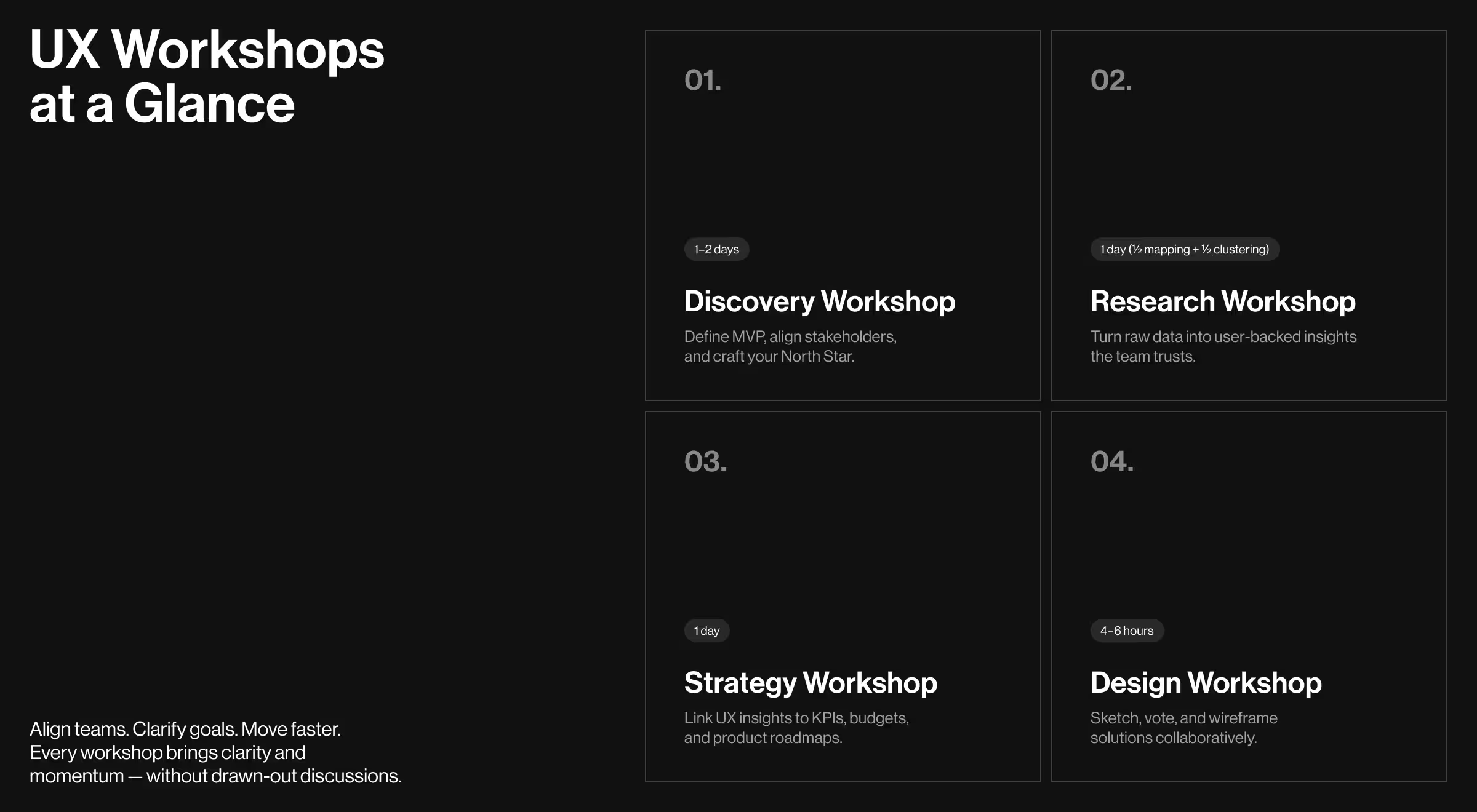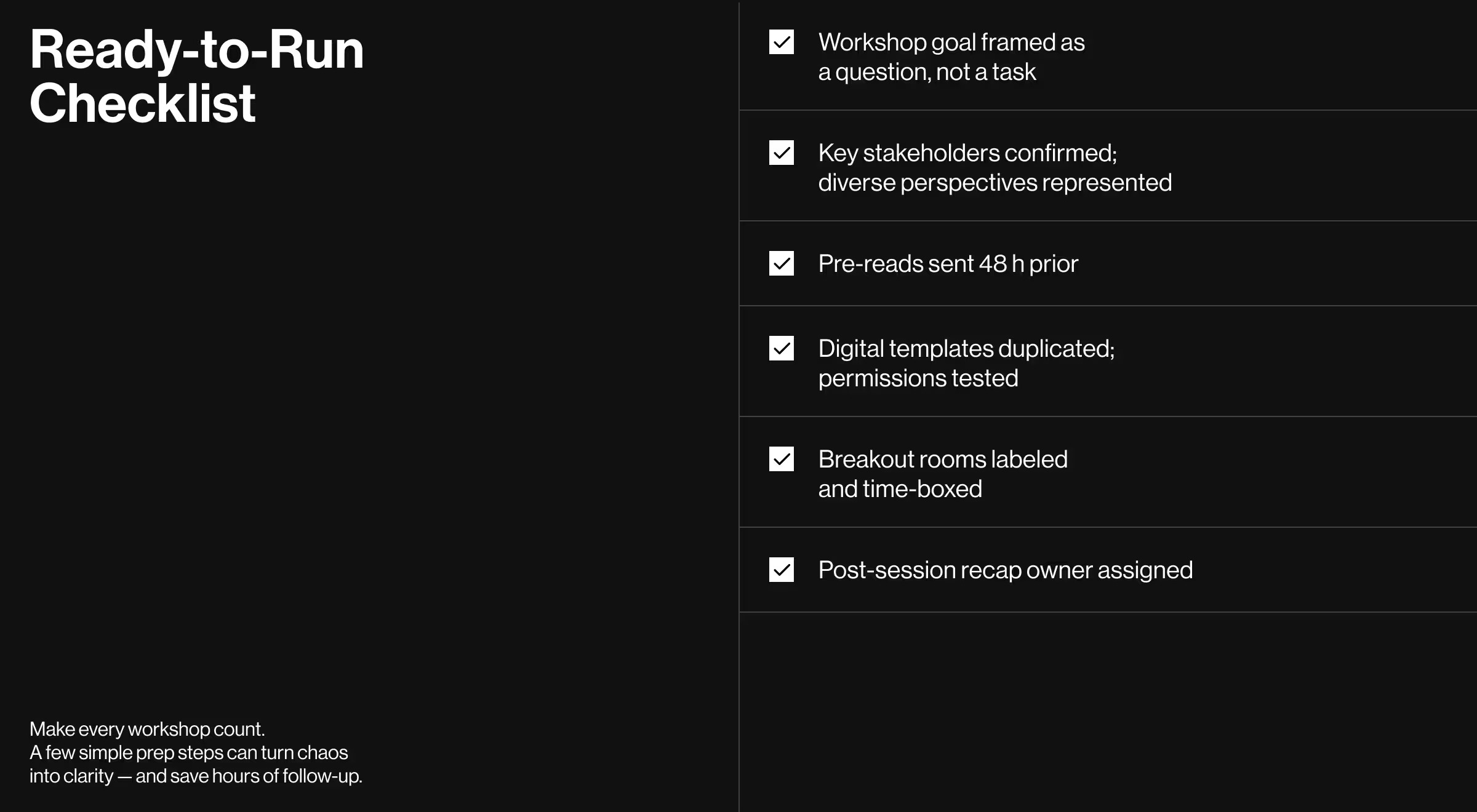Every UX workshop at Lazarev.agency starts with the same goal: give a diverse group of stakeholders one concentrated time-box to agree on the next, most valuable move.
Done well, these intensive collaborative sessions collapse weeks of back-and-forth into a single afternoon and turn vague ideas into concrete, shared direction.
Below you’ll find 4 workshop types we rely on, the practical hacks our UX designers use to keep momentum high in remote UX workshops, and a readiness checklist you can copy-paste into your next invite.
Key Takeaways
- Match the session to the stage. Discovery uncovers what to build, research explains why, strategy aligns on where next, design workshops sketch how it looks.
- Time-box mercilessly. Most insights surface in the first 90 minutes; a tight clock enables progress and prevents scope creep.
- Make artifacts portable. Each workshop produces a living board the team can keep editing — no PDF graveyards.
- Measure business impact. Teams that embed design thinking practices ship to market up to twice as fast as those that don’t.

UX Discovery Workshop — Find the North Star
Design-led companies that run workshops as part of their regular design process outperform peers by 32% higher revenue growth and 56% higher shareholder returns over 5 years — evidence by McKinsey that shared ownership turns into measurable project success.
Most founders arrive with a laundry list of features; this workshop cuts the noise to the 3-4 that move the revenue needle first.
A UX discovery workshop kicks off a new initiative or major pivot. The aim is to surface existing knowledge, align stakeholder expectations, and frame the first hypothesis MVP.
Typical timeline (1-2 days, in-person workshop or remote UX):
- Stakeholder mapping. Map power vs. interest; invite at least one voice from customer support to shift stakeholder perspectives beyond leadership.
- Problem-framing canvas. Write each pain point on sticky notes; cluster to identify patterns and prioritise user pain versus business pressure.
- North-star statement. Craft a single sentence every team member can finish without notes.
Outputs: user-journey snapshot, prioritized assumption list, early project milestones.
The immediate win: a North-Star statement everyone can quote and a risk ledger that prevents scope creep before it begins.
At Lazarev.agency, empathy is woven into the discovery routine. Stakeholder mapping, the pre-mortem survey, and first-day interviews already surface pain points and user needs. Breaking those moves into a standalone session would pad the timeline without adding insight.
🔍 Quick hack: send a ten-question pre-mortem survey 48 hours in advance. When workshop participants arrive, the “What could kill this?” fears are on paper, not lingering in the conference room.
UX Research Workshop: Turn Data into Insight
“Raw data is just trivia until a roomful of perspectives turns it into patterns the whole team trusts.”
{{Oleksandr Koshytskyi}}
After interviews or diary studies, a UX research workshop helps a small group identify patterns and build consensus around real user needs.
Timeline (½ day affinity mapping + ½ day insight clustering):
- Import raw user research notes into a digital whiteboard; color-code by persona.
- Run silent grouping; then annotate each cluster with a verb + pain: “track delivery anxiety,” “compare subscription tiers.”
- Vote on insight strength; park any claim without evidence.
Outputs: evidence-backed insight clusters, updated user journey, refined research backlog.
🔍 Quick hack: schedule a 5-minute “evidence ping” every quarter-hour. Any statement without a source sticky moves to the parking lot. Group discussions stay grounded.
UX Strategy Workshop: Map the Road Ahead
Insights are priceless until they sit in a slide deck. Strategy workshop links them to KPIs and sprint budgets so they survive executive review.
Once insights are stable, a UX strategy workshop connects them to business metrics and planned feature releases.
Timeline (1 day, often remote-friendly):
- Value-Effort Matrix. Place features; slice the upper-right quadrant for quick wins.
- KPI Tree. Link UX outcomes (e.g., reduced task time) to higher-level objectives (revenue, churn).
- Quarterly OKRs. Assign a metric owner; mark dependencies on other teams.
Outputs: one-page roadmap, KPI owner list, shared design timeline.
Teams leave with a one-page roadmap and a named KPI owner, which means progress is measurable at the very next stand-up.
🔍 Quick hack: start with risks, then ideas. Listing red flags first halves “features first” mindset and protects project direction from scope creep.
UX Design Workshop: Visualize the Solution
This is where sketches replace speculation.
A UX design workshop turns strategy into wireframes fast. Think design-studio meets critique workshop.
Timeline (4-6 hours):
- Crazy-8s sketching → silent heat-map voting → discuss top ideas.
- Merge winning sketches into one wireflow; annotate interactions.
- Decide prototype fidelity; assign roles to product managers, UX team leads, and other designers.
Outputs: consensus wireframes, prototype plan, decision log.
🔍 Quick hack: preload the board with brand tokens and grid templates, so a diverse group can sketch without hunting assets. Hands-on activities stay focused on new ideas, not tool setup.
UX Workshop Cheat-Sheet
- UX discovery workshop: vision, risks, KPIs | 1-2 days.
- UX research workshop: pattern mining, insight ranking | 1 day.
- UX strategy workshop: roadmap & KPI tree | 1 day.
- UX design workshop: concept sketch & prototype scope | < 1 day.
Keep the cheat sheet visible; it reminds workshop participants that each format has its own set of outcomes and prevents accidental overlap.
Four Core UX Workshops in Comparison
Lazarev.agency Insider Hacks
6 field-tested tricks from our UX designers that keep even remote UX workshops decisive and momentum-rich:
- 48-hour sprint brief. Every team member receives context early, so in-person or remote UX workshops start hot.
- Dual-track facilitation. One lead drives the dialogue; a second captures artifacts live, enabling progress without note lag.
- Micro-break timers. Five-minute stand-ups every 50 minutes limit fatigue and build empathy across different teams.
- Live template links. Stakeholder map, journey map, prioritization exercises — all a single click away.
- Risk ledger first. Listing fears before idea generation activities shifts stakeholder perspectives and keeps a user-first lens.
- Async recap video. A two-minute Loom sent the same day maintains momentum and shared ownership.
Put these habits in place, and every intensive collaborative session will end with decisions on the board. Check the items below to make sure your next workshop is truly launch-ready.
Ready-to-Run Checklist
Minimum safety net! If any box below stays unchecked, the session risks turning into just another long meeting:

From Workshops to Momentum
Companies that run this cycle see revenue climb faster and prototypes hit the market sooner:
- UX discovery workshops clear the fog at kickoff and build empathy for user needs.
- UX research workshops turn many ideas into evidence-backed insights.
- UX strategy workshops convert insights into a roadmap that stakeholders trust.
- UX design workshops visualize solutions, so everyone can critique step by step.
In short, structured workshops prioritize user value, align key stakeholders, and enable progress without endless meetings.
Let’s Workshop Your Next Move
Need clarity on which workshop gets you moving?
If your backlog is ballooning or stakeholder expectations keep shifting, book a short call.
We’ll help you pick a workshop that surfaces the next actionable priority and fits the time you actually have.





























.webp)













%20(1).png)
%20(1)%20(1).avif)
.avif)



